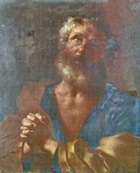

Antonio Maria Fabrizi, who was born in Perugia,seems to have trained in Rome. If so, he had returned to his native city by 1630, and spent the rest of his career there.
Perugia
Scenes from the life of St Florentius (1612-30)
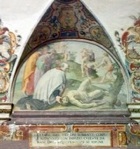
-
✴The first seven are by Matteucci Salvucci, who worked on them until his death in 1627.
-
✴The other six are by Antonio Maria Fabrizi. They include this one in which Bishop Decentius of Perugia retrieves the martyr’s body from the Tiber.
St Florentius (1630)
This altarpiece from San Fiorenzo, which is attributed to Antonio Maria Fabrizi [and dated by inscription ??] is now in the Galleria Nazionale.
Work in San Simone del Carmine (ca. 1630)
A fresco cycle by Antonio Maria Fabrizi in San Simone del Carmine was mostly destroyed when the interior itself was remodelled in 1854-6. However, a fresco of the Allegory of Chastity in the vault of the nave was preserved within the later pictorial cycle by Mariano Piervittori, as a record of Fabrizi’s work in the church.
Some of the work that Fabrizi did at this time in the convent also survives, including:
-
✴a fine fresco (1630) of the Baptism of Christ, which is signed and dated by inscription, on the ceiling of what was the Stanza del Vice Priore; and
-
✴five lunettes depicting scenes from the life of the prophet Elijah in what was the refectory.
They are illustrated in the book edited by Antonio Carlo Ponti, referenced below.
Work in San Domenico (1630-44)
Antonio Maria Fabrizi worked in San Domenico after its remodelling in 1625-32.
Panels (1630)
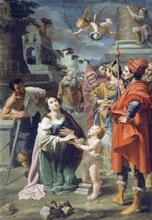

According to local historians, Antonio Maria Fabrizi decorated the newly-designated Cappella del Rosario (the inner apsidal chapel on the right) in 1630. His frescoes here were destroyed when the chapel was restored in 1956. The two panels from the side walls, which are now under the organ in the right transept, depict:
-
✴the martyrdom of St Dorothy; and
-
✴SS Cecilia and Valerian.
Madonna and Child with saints (1644)

This framed fresco on the counter-facade, which depicts the Madonna and Child with SS Constantius, Dominic, Catherine of Siena and Herculanus. The Madonna hands rosaries to each of SS Dominic and Catherine of Siena while St Herculanus intercedes on behalf of a group of kneeling nuns and noble women. The lower part is set against a cityscape painted from outside Porta San Girolamo, with San Pietro to the left and San Domenico to the right.
Local historians often date the fresco to 1656, when Perugia escaped an outbreak of plague. However, Antonio Maria Fabrizi was dead by then. The date 1644 was given by Ottavio Lancellotti in his “Scorta Sagra” (17th century): Lancellotti knew the artist and indeed commissioned an altarpiece from him (see below).
Frescoes in San Filippo Neri (17th century)
Antonio Maria Fabrizi was responsible for work in two chapels in San Filippo Neri:
Frescoes in the Cappella dell' Assunzione (1632-5)
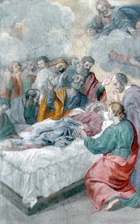

Death of the Virgin Apostles and the empty grave
These frescoes depict:
-
✴in the vaults, the cloud that represents God, surrounded by musical angels; and
-
✴on the walls, two scenes (illustrated here) that completed the story that was depicted in the original altarpiece of the Assumption of the Virgin by Guido Reni:
-
•the Death of the Virgin; and
-
•the Apostles around her empty grave .
Frescoes in the Cappella della Natività (1636-42)

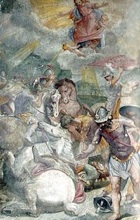
Calling of St Peter Conversion of St Paul
These frescoes depict:
-
✴in the vaults:
-
•God the Father; and
-
•two scenes from the life of Jacob:
-
-his dream of a ladder to Heaven; and
-
-his fight with an angel, after which his name was changed to “Israel”; and
-
✴on the walls (illustrated here):
-
•the calling of St Peter; and
-
•the conversion of St Paul.
Frescoes (1641)
These documented frescoes by Antonio Maria Fabrizi in the chapel belonging to Sebastiano Fiori in the ex-Chiesa del Suffragio have been destroyed.
Madonna and Child with saints (ca. 1644)
Ottavio Lancellotti recorded in his “Scorta Sagra” (17th century) that Antonio Maria Fabrizi had painted this altarpiece for his family chapel in SS Stefano e Biagio. When this church was deconsecrated in 1829, the altarpiece was moved to SS Biagio e Savino in Piazza Leone III on the outskirts of Perugia. The altarpiece (which is illustrated in the website of the Fondazione Federico Zeri) depicts the Madonna and Child in glory with SS Octavian and Apollonia (who holds the pincers with which her teeth were torn out).
Work in the Chiesa del Gesù (1666-7)
The frescoes on the ceiling of the Oratorio degli Artisti in the Chiesa del Gesù, which have Marian iconography, are by Antonio Maria Fabrizi and Giovanni Andrea Carlone, il Genovese.
Work in the Convento di Monteripido (17th century)

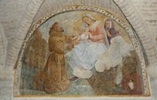
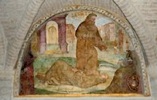
These three frescoes in lunettes along the east side of the second cloister of the Convento di Monteripido, which are attributed to Antonio Maria Fabrizi, depict (from the left):
-
✴St Francis speaking to a knight (perhaps Count Orlando di Chiusi, who gave Mount Alvernia to the Franciscans);
-
✴St Francis’ vision of the Madonna and Child, in which she offers the baby Jesus to him; and
-
✴a friar placing his foot on the chest of St Francis, who is prostrated by demonic images (an incident that happened at San Pietro a Bovara).
Each of the three is decorated with the arms of its donor.
Martyrdom of St Laurence (17th century)
This panel [from the Duomo ?], which is now in the Museo Capitolare, is attributed to Antonio Maria Fabrizi.
Bettona
St Peter (17th century)
